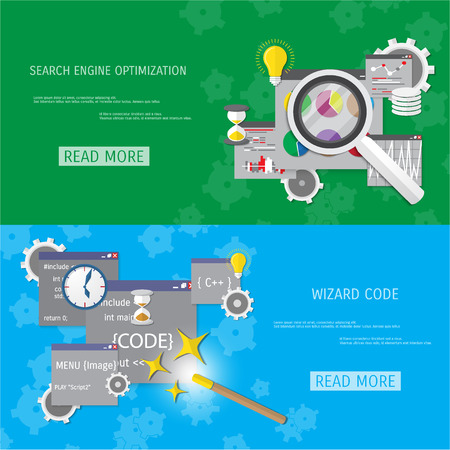1. Understanding Semantic HTML
Semantic HTML refers to the use of HTML tags that clearly describe their meaning and purpose in the content they contain. Unlike non-semantic tags like <div> or <span>, semantic elements such as <header>, <article>, and <footer> help both browsers and search engines understand the structure and importance of different parts of a webpage.
Why Semantic HTML Matters
Google’s ranking algorithm increasingly favors websites that are easy to understand and navigate—not just for users, but for bots as well. Semantic HTML improves accessibility, enhances SEO, and provides meaningful context to search engines, which helps your content get indexed and ranked more accurately.
Key Semantic Elements
The following are some of the most commonly used semantic HTML tags and their typical use cases:
| Tag | Description | Common Use |
|---|---|---|
| <header> | Defines introductory content or navigational links | Top section of a webpage or an article |
| <nav> | Contains the navigation menu | Main site or page navigation |
| <main> | Specifies the main content of a document | Primary information unique to the page |
| <article> | Represents a self-contained composition | Blog posts, news articles |
| <section> | Groups related content together | Thematic grouping within a page |
| <aside> | Holds content indirectly related to the main content | Sidebars, pull quotes, advertisements |
| <footer> | Defines footer for a section or page | Copyright info, contact links |
The Impact on SEO and Accessibility
Using semantic tags allows screen readers and other assistive technologies to better interpret your sites layout. For Google, this structured approach makes it easier to crawl and categorize your pages. Pages with clear semantics are more likely to appear in relevant search results because Google understands what each part of the page is about.
Benefits at a Glance:
- Improved indexing by search engines
- Better user experience through consistent structure
- Easier maintenance and scalability for developers
Pro Tip:
Avoid using generic tags like <div> when a semantic tag is available. It not only boosts your SEO but also makes your code cleaner and easier to read.
2. How Google Interprets Semantic HTML
When it comes to understanding your website, Google relies on a tool called Googlebot. This is the search engines crawler that scans and indexes web pages. One of the ways Googlebot understands what a page is about is through semantic HTML. Semantic HTML uses meaningful tags like <article>, <header>, <footer>, and <section> to give structure and context to content.
Why Semantic Tags Matter
Using proper semantic tags helps Googlebot figure out which parts of your webpage are important and how they relate to each other. For example, placing your main content inside an <article> tag tells Google that this section is central to the page. Likewise, using <nav> helps identify navigation menus, while <aside> indicates side content like related links or ads.
How Googlebot Processes Semantic HTML
Googlebot reads your HTML code from top to bottom. When it encounters semantic tags, it builds a mental map of your page layout. This map helps Google determine the hierarchy and relevance of different sections. Here’s a simplified view of how semantic HTML helps organize information:
| Semantic Tag | Purpose | How Googlebot Uses It |
|---|---|---|
| <header> | Top section of the page, usually contains logo or title | Identifies introductory content or branding |
| <nav> | Main site navigation | Understands internal linking and site structure |
| <main> | Main content area of the page | Focuses indexing efforts on core content |
| <article> | A standalone piece of content like a blog post | Treats it as primary information for ranking |
| <section> | Thematic grouping of content within a page | Helps understand topic segmentation |
| <footer> | Bottom section with extra info or links | Takes note of supporting information or contact details |
The Impact on SEO Performance
By using semantic HTML correctly, youre not just helping visually impaired users with screen readers—you’re also giving Google clearer signals about your content’s purpose. This can lead to better indexing and potentially higher rankings because Google can more accurately match your pages with relevant search queries.
Avoid Common Mistakes
- Dont misuse tags: Avoid using semantic tags for styling only. They should reflect actual content structure.
- Avoid excessive nesting: Keep your semantic structure clean and easy to follow.
- Be consistent: Use similar tagging patterns across your site to help Google recognize recurring structures.
Tip:
If you’re using WordPress, many modern themes already include basic semantic elements. However, its still good practice to review your theme’s code or use a plugin that enhances semantic markup for SEO purposes.

3. Impact of Semantic HTML on SEO
Semantic HTML plays a key role in how Google understands and ranks your content. It goes beyond just making your code look clean — it helps search engines figure out what each part of your webpage means. Let’s break down both the direct and indirect effects semantic markup has on your sites SEO.
Direct Effects on Search Engine Rankings
When you use semantic HTML elements like <header>, <article>, <section>, and <footer>, youre giving Google clear signals about the structure and importance of your content. This makes it easier for Googles crawlers to index your site accurately, which can improve how your pages show up in search results.
Key Semantic Tags and Their SEO Benefits
| Semantic Tag | Purpose | SEO Benefit |
|---|---|---|
| <header> | Defines the top section of a page or section | Helps identify introductory content and primary navigation |
| <nav> | Specifies navigation links | Makes site structure clearer for crawlers |
| <article> | Represents self-contained content | Tells Google this is stand-alone, valuable content |
| <section> | Groups related content together | Aids in understanding content hierarchy |
| <footer> | Adds closing information like contact details or links | Gives context about authorship or site organization |
Indirect Effects on SEO Performance
The indirect benefits of semantic HTML are just as important. By using semantic tags, youre also improving user experience (UX) and accessibility, both of which Google values when ranking pages.
User Experience & Accessibility
- Easier Navigation: Clear structure helps users find what they’re looking for faster.
- Screen Reader Compatibility: Semantic elements make it easier for assistive technologies to interpret page content.
- Faster Indexing: Clean, well-structured code can be crawled more efficiently by search engines.
The Bottom Line for SEO
If Google can understand your content better, it’s more likely to rank it higher. Using semantic HTML doesn’t guarantee top rankings, but it does give your website a technical foundation that supports other SEO efforts like quality content and link building.
4. Best Practices for Implementing Semantic HTML
Using semantic HTML not only helps search engines like Google understand your content better, but it also improves accessibility for users who rely on assistive technologies. Below are some practical tips and examples to help you use semantic elements effectively.
Use the Right Tags for the Right Content
Semantic tags describe the meaning of the content inside them, which helps both SEO and accessibility. Here’s a quick guide:
| Element | Purpose | Example Use |
|---|---|---|
| <header> | Defines introductory content or navigational links | Website logo and main menu |
| <nav> | Contains navigation links | Main site navigation or sidebar menu |
| <main> | Main content of the document (one per page) | Blog post, article body |
| <article> | Self-contained composition that can stand alone | A single blog post or news story |
| <section> | Thematic grouping of content, typically with a heading | A services overview section on a homepage |
| <aside> | Content related to the main content but not essential to it | A callout box or sidebar with related links |
| <footer> | Footer for its nearest sectioning content or entire page | Contact info, copyright statement |
Add Headings in Logical Order
Use headings (<h1> through <h6>) to structure your content clearly. Each page should have one <h1>, usually for the main topic. Subheadings should follow in order:
Example:
<h1>How to Bake a Cake</h1><h2>Ingredients</h2><h3>Dry Ingredients</h3><h3>Wet Ingredients</h3><h2>Instructions</h2><h3>Mixing the Batter</h3><h3>Baking Time</h3>
This helps screen readers and search engines understand the hierarchy and flow of information.
Use Lists for Grouped Information
If youre presenting steps, features, or any grouped data, use ordered (<ol>) or unordered (<ul>) lists. This is more accessible than using plain paragraphs or divs.
Example:
<ul> <li>Fast loading times</li> <li>Mobile-friendly design</li> <li>Clear calls-to-action</li></ul>
Add Alt Text to Images
Always include descriptive alt text for images using the alt="" attribute. This supports screen readers and gives search engines more context about your content.
Example:
<img src="chocolate-cake.jpg" alt="Freshly baked chocolate cake on a white plate">
Avoid Using Non-Semantic Elements When Not Necessary
Try not to use generic tags like <div> and <span>, unless you need them for styling purposes. Replacing them with semantic elements makes your code cleaner and more meaningful.
Instead of this:
<div class="blog-post"></div>
Use this:
<article class="blog-post"></article>
Implementing these best practices will make your website easier to navigate, better understood by Googles algorithms, and more accessible to all users.
5. Common Mistakes to Avoid
Using semantic HTML correctly can have a big impact on how Google understands and ranks your website. However, many developers make common mistakes that can hurt SEO performance. Below are some of the frequent errors and how they can negatively affect search visibility.
Misusing Semantic Elements
One of the most common issues is using semantic tags incorrectly or for styling purposes only. For example, using a <header> tag just to apply a background image, instead of marking up actual introductory content. This confuses search engines and weakens your sites structure.
Example:
| Incorrect Usage | Correct Usage |
|---|---|
| <header style=”background:url(banner.jpg)”></header> | <header><h1>Welcome to Our Blog</h1><p>Latest news and updates</p></header> |
Skipping Important Tags
Another mistake is not using essential semantic elements like <main>, <article>, or <section>. These tags help Google understand the layout and priority of your content. Skipping them makes it harder for search engines to figure out what your page is really about.
Overusing Non-Semantic Tags
Relying too much on <div> and <span> for all content blocks can weaken the meaning of your page structure. While these tags are useful for layout, they don’t tell Google anything about the purpose of the content inside.
A Better Approach:
| Poor Structure | Improved Structure |
|---|---|
| <div class=”post”><div class=”title”>Hello World</div></div> | <article><h2>Hello World</h2></article> |
Nesting Errors
Nesting semantic tags improperly—like placing a <footer> inside a <header>—can create confusion for crawlers. Make sure each element is used in its proper context to maintain clear hierarchy and meaning.
Lack of Heading Hierarchy
Headings should follow a logical order (e.g., <h1> followed by <h2>, then <h3>). Jumping around levels or using multiple <h1>s on one page can signal poor structure to search engines, potentially lowering your rankings.
Heading Example:
| Poor Heading Use | Better Heading Use |
|---|---|
| <h1>Home</h1><h3>About Us</h3><h2>Contact</h2> | <h1>Home</h1><h2>About Us</h2><h2>Contact</h2> |
Avoiding these common mistakes can greatly improve how search engines interpret your site’s content, which boosts your chances of ranking higher in search results. Paying attention to semantic accuracy is a simple but powerful step in SEO success.
6. Future of Semantic HTML in Search Algorithms
As Googles search algorithms continue to evolve, the role of semantic HTML is expected to become even more important. Google is constantly refining how it understands and ranks content, and semantic structure helps the algorithm better interpret what each part of a webpage means.
Why Semantic HTML Matters More Than Ever
Semantic HTML uses specific tags like <article>, <section>, <header>, and <footer> to give meaning to different parts of a page. These tags help Google understand the context and purpose of content, which leads to better indexing and ranking.
With the rise of technologies like AI and machine learning in search engines, having clean and well-structured semantic HTML can make a big difference. It allows Googles bots to easily identify key content areas, which can improve visibility in search results.
What Webmasters Should Watch For
As we look ahead, here are some things webmasters should keep an eye on:
| Trend | What It Means | Action for Webmasters |
|---|---|---|
| More Emphasis on Contextual Understanding | Google may rely more on how content fits together semantically | Use proper semantic tags to define sections clearly |
| User Intent Matching | The algorithm will get better at matching content with user queries based on structure | Create content that answers specific questions within well-defined HTML sections |
| Accessibility Integration | Screens readers and accessibility tools benefit from semantic HTML, which could influence rankings | Ensure your site is accessible by using correct HTML elements like <nav>, <main>, etc. |
| Enhanced Rich Snippets | A well-structured page can lead to more featured snippets in SERPs | Add schema markup and use semantic tags consistently throughout your site |
The Bottom Line for Future-Proofing Your Site
If you want your website to stay competitive in search rankings, now is the time to invest in strong semantic structure. Think beyond just keywords—focus on how your content is organized and labeled with HTML. Google’s algorithm will likely reward pages that make it easy to understand both layout and context.
This shift doesn’t mean you need complex code—it means using the right tags for the right job. Keep learning about updates from Google, and always test your sites structure using tools like Lighthouse or Google Search Console.
The future of SEO is not just about what you say—its also about how you say it in your code.

